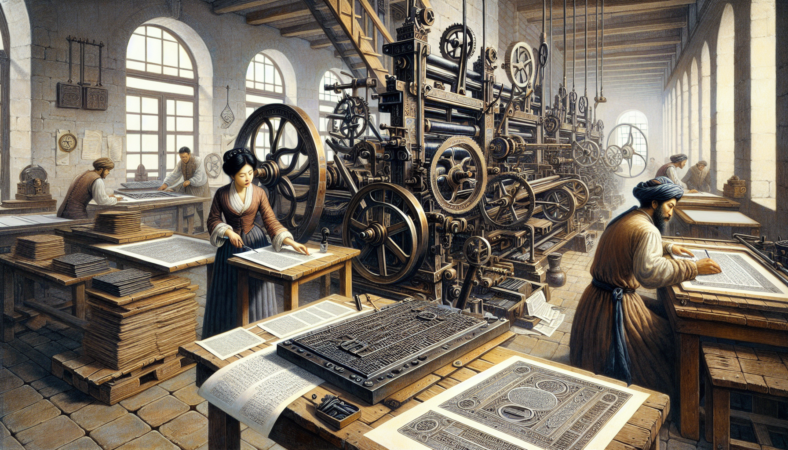“Design is not just what it looks like and feels like. Design is how it works.” – Steve Jobs
In today’s digital era, where most of our lives are spent staring at screens, there is a certain charm in the world of printing design. The tactile experience of holding a beautifully crafted print piece in your hands is something that cannot be replicated by pixels on a screen. Printing design is more than just putting ink on paper; it is a combination of art and science that requires careful consideration of various elements. In this blog post, we will explore the intricacies of printing design, from understanding the basics to creating stunning visual experiences.
Understanding the Basics of Printing Design
Before diving into the creative process, it’s important to understand the fundamental aspects of printing design. This knowledge will help you make informed decisions and ensure that your designs translate well from screen to print.
Resolution and Color Modes
Resolution plays a crucial role in printing design. Unlike digital design, where high-resolution images are readily available, printing requires a higher level of detail. Images with lower resolution may appear pixelated or blurry when printed. It is essential to use high-resolution images and graphics to maintain the visual quality of your design.
Color modes are another key consideration. The two primary color modes are RGB (Red, Green, Blue), used for screen display, and CMYK (Cyan, Magenta, Yellow, Black), used for printing. When designing for print, always work in CMYK mode to ensure accurate color representation.
Bleed and Margin
Bleed and margin are crucial elements that must be considered to avoid any potential issues during printing. Bleed refers to the area beyond the final size of your design that will be trimmed off. To avoid unsightly white edges, it’s important to extend your background or images slightly beyond the intended dimensions.
Margins, on the other hand, define the safe zone within which important content should be placed to avoid being cut off. Keeping essential text and graphics within the margin ensures that no critical information is lost during the trimming process.
The Creative Process of Printing Design
Now that we have covered the basics, let’s delve into the creative process of printing design. This phase is where the magic happens and where a well-executed design can truly shine.
Understanding the Purpose
Every print project has a purpose, be it showcasing a product, promoting an event, or providing information. Understanding the purpose and target audience is crucial for effective design. The design should align with the message you want to convey and resonate with the intended audience.
Typography and Fonts
Typography plays a significant role in printing design as it sets the tone and reflects the personality of the brand or message. Choosing the right font for your project is pivotal. Fonts evoke specific emotions and can enhance or detract from the overall design. Combining multiple fonts can create visual hierarchy and add interest to your design.
Layout and Composition
The layout and composition of your design determine the flow of information and create visual harmony. The grid system is a powerful tool that provides structure and helps maintain consistency. It ensures visual balance across all elements and makes the design aesthetically pleasing.
Using grids, you can organize text, images, and other design elements effectively, guiding the reader’s eye through the piece. Experimenting with different layouts and compositions can create unique design experiences.
Color and Contrast
Color is undoubtedly one of the most impactful design elements. It evokes emotions, creates visual interest, and reinforces brand identity. When choosing colors for your print design, consider the psychology behind color and its effect on the target audience. Combining complementary colors and playing with contrast can make your design visually striking.
Finishing Touches
Finishing touches can elevate your print design from ordinary to extraordinary. Techniques such as embossing, foiling, varnishing, and die-cutting add texture, depth, and uniqueness to your design. Though these techniques add to the cost, they provide a premium look and feel that captivates the audience.
Preparing for Print Production
Once your design is ready, it’s time to prepare it for print production. However, before sending it off to the printer, there are a few essential steps to ensure a smooth and successful printing process.
Proofreading
Proofreading is critical to avoid any embarrassing typos or errors in your design. Go through all the text and graphics meticulously to catch any mistakes. It’s advisable to have someone else review your design as well, as fresh eyes may pick up on things that you might have missed.
Print File Setup
Preparing your design files properly is crucial for a hassle-free printing experience. Ensure that your files are in the correct format (PDF is often preferred), with all fonts embedded and images linked correctly. If your project includes special colors, clearly specify the Pantone colors you have used.
Test Prints
Before committing to the full print run, it’s always wise to request test prints. Test prints allow you to see how your design translates from the digital world to the physical realm. You can assess the colors, resolution, and overall quality of the print. Any necessary adjustments can be made based on these test prints.
Conclusion
Printing design is a captivating blend of creativity, technicality, and attention to detail. It is a discipline that requires understanding the basics, honing the creative process, and mastering the technical aspects of preparing files for print. By incorporating the principles mentioned in this article and practicing constantly, you can create visually stunning designs that leave a lasting impression on your audience. So, go ahead, explore the realm of printing design, and let your creativity shine on paper!





